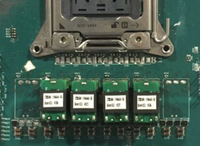Vicor, ST, TI, seems like everyone and their 1st cousin are ready and see this coming but us.
Problem is power wasted by hot [H]ard switching regulators each time they open and close.
Yeah, you can have lots of phases, and spread the problem out over an area, but it still adds
up the same wasted power.
There is built in parasitic capacitance that discharges like an unseen spark at every closure.
Thats a problem like a built-in bomb, but the capacitance is also necessary (and sometimes
more intentionally added), cause it protects the switch from blowing when it reopens due to
current stored both by necessary and parasitic inductance. Dual purpose bomb and pillow...
Solution is a resonant power converter that provides periodic opportunities to switch at near
zero current or voltage. The cap protects the switch at opening, the inductor discharges the
cap before closing. A dance that is sometimes hard to balance, especially if the load is not
a steady draw. But when done right, wastes almost no heat.
Don't actually need 48V to do this, 12V rail works fine too. But 48V gives some advantage.
Capacitance can be made non-linear with higher voltage swings, and that gives more pillow
time to catch the voltage while its near each rail without adding a lot of extra stored energy.
And that means it could maybe operate without heatsink over a much wider range of load.
I could elaborate to the point of schematics, but only if doing so would not be wasting your
time. Comments, suggestions, dirty jokes???
Problem is power wasted by hot [H]ard switching regulators each time they open and close.
Yeah, you can have lots of phases, and spread the problem out over an area, but it still adds
up the same wasted power.
There is built in parasitic capacitance that discharges like an unseen spark at every closure.
Thats a problem like a built-in bomb, but the capacitance is also necessary (and sometimes
more intentionally added), cause it protects the switch from blowing when it reopens due to
current stored both by necessary and parasitic inductance. Dual purpose bomb and pillow...
Solution is a resonant power converter that provides periodic opportunities to switch at near
zero current or voltage. The cap protects the switch at opening, the inductor discharges the
cap before closing. A dance that is sometimes hard to balance, especially if the load is not
a steady draw. But when done right, wastes almost no heat.
Don't actually need 48V to do this, 12V rail works fine too. But 48V gives some advantage.
Capacitance can be made non-linear with higher voltage swings, and that gives more pillow
time to catch the voltage while its near each rail without adding a lot of extra stored energy.
And that means it could maybe operate without heatsink over a much wider range of load.
I could elaborate to the point of schematics, but only if doing so would not be wasting your
time. Comments, suggestions, dirty jokes???
Last edited:
![[H]ard|Forum](/styles/hardforum/xenforo/logo_dark.png)


